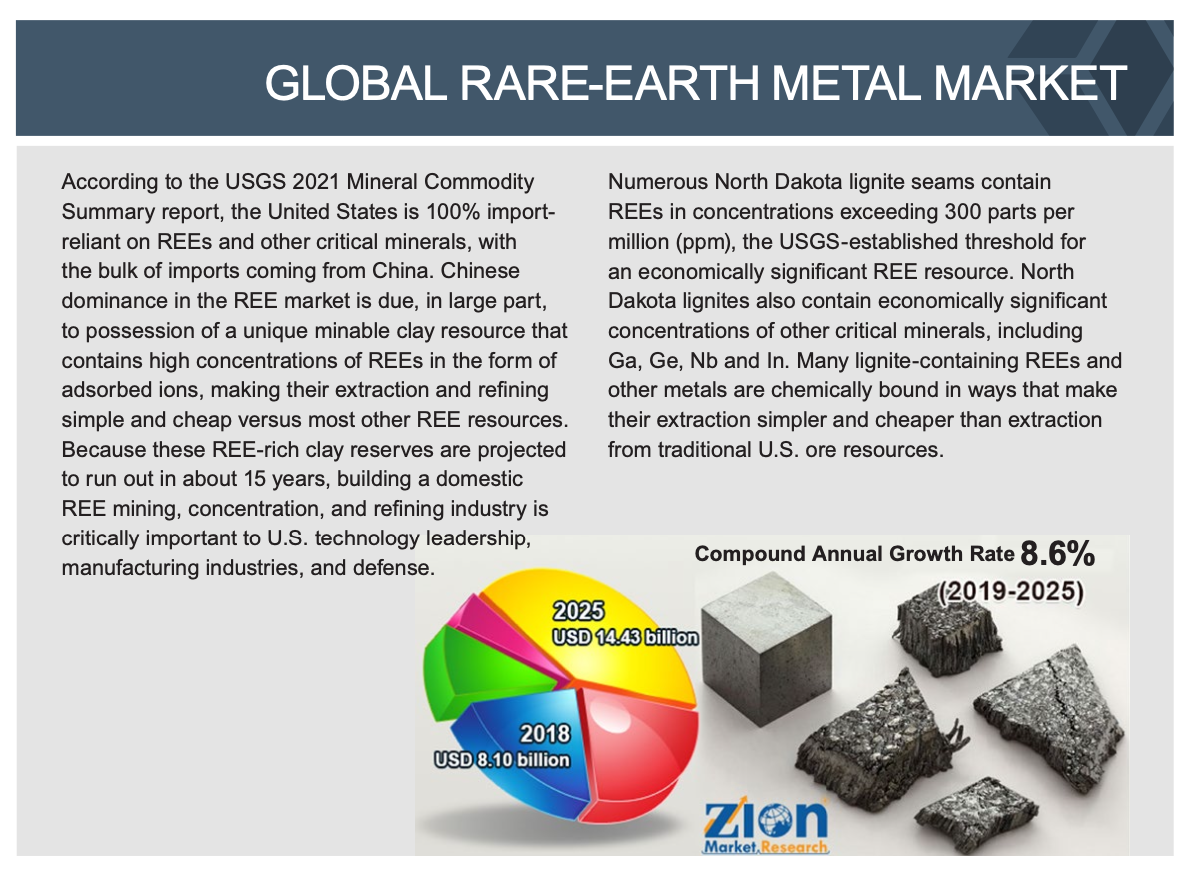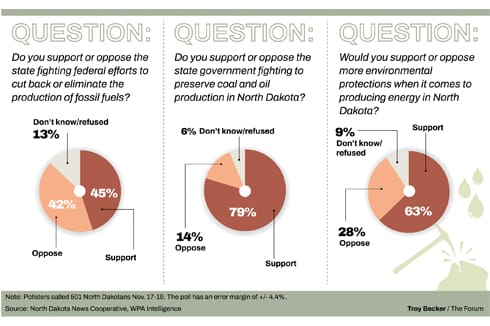ND readies for mineral boom
First outcomes in 3-5 years, full development a decade away

China’s stranglehold on supply chains for rare earth and critical mineral elements presents North Dakota with the opportunity to capitalize on a new resource boom.
With some of the highest concentrations of rare earth and critical mineral elements in the U.S., the state is in prime position to supply tech minerals crucial to building everything from electric vehicles to semiconductors to jets and nuclear submarines.
Lynn Helms, director of the state’s Department of Mineral Resources, estimated the potential value of rare earth deposits to be “in the billions of dollars” when addressing the House Energy and Natural Resources Committee in early January.
At the moment those projected billions of dollars are locked away in the billions of bits of minerals scattered throughout lignite coal and in other rocky outcrops around the state.
How soon and how fast development occurs depends on a variety of factors, including the fluctuating value of the minerals as well as their supply.
Moves by China – which processes and purifies most of the rare earths globally – will factor in.
China’s government has the potential to flood the market and decrease the value of a particular mineral making it less profitable to mine, or restrict access and drive its cost up and reduce availability, since its state-controlled companies monopolize the processing.
“I think the China threat is real and it could happen quickly,” U.S. Senator Kevin Cramer said in an interview with NDNC. “We’re behind in so many areas, and so many categories, and critical minerals is one of those areas, especially as we expand our space capabilities.”
China is currently finalizing a new technology export control list that could further restrict the availability of magnet processing technology used in wind turbines, electric vehicles and aerospace technology on national security grounds.
Currently, the United States imports more than 80 percent of its rare earth elements and critical minerals, according to the U.S. Department of Energy [DOE].
At the end of March, the U.S. and Japan signed a bilateral trade agreement on strengthening critical mineral supply chains related to electric vehicle battery production as part of an effort to ward off potential disruptions by China actions restricting access to those materials.
The deal also allows Japanese auto companies better access to Inflation Reduction Act Clean Vehicle Credits related to requirements for batteries and raw materials to be extracted and processed in the U.S.
“If everyone’s going to drive an EV, and if everybody’s going to do wind and solar, all those things take critical minerals,” said Jonathan Fortner, a government affairs specialist at Lignite Energy Council. “From a national security standpoint, to be totally dependent on China . . . that’s not a good place to be.”
Tech minerals leader
North Dakota could be at the head of the pack when it comes to extracting and processing tech minerals if everything falls into place. That process will take some time to play out, however.
By North Dakota Industrial Commission estimates, over $13.5 million has been spent in federal and state dollars on research projects examining the potential to extract and process rare earths and critical minerals from lignite coal seams and coal byproducts in the state so far.
Overarching all of this is the Williston Basin Carbon Ore, Rare Earth and Critical Minerals (CORE-CM) Initiative, tasked with surveying parts of North Dakota, eastern Montana and portions of northwest South Dakota to find the highest concentrations of these tech minerals.
It is one of 13 programs around the country funded by the Department of Energy [DOE] to determine the best places to economically extract the minerals in regions primarily known for producing coal.
When it comes to North Dakota’s potential place in the tech minerals hierarchy, “We’re in the front,” said John Kay, an engineer with the Energy and Environment Research Center at UND who is leading the CORE-CM Initiative.
“We’re not the front, I’m not going to brag that much, but we’re in the front,” Kay said. “We believe we have resources that can be utilized and it’s in areas that are easily accessible.”
Kay said it “just makes sense” to start by trying to extract these minerals from lignite coal seams at existing mines.
While there are other potential deposits of rare earths and critical minerals around the state, concentrating on mines that are already operating and setting up a processing facility next to the seam simplifies extraction and minimizes environmental concerns.
“From the purpose of speed to market as well as saving a lot of costs, having it in an existing lignite mine is a gigantic boon, because you don’t have to permit and deploy said mine because it is immediately right there,” said Nolan Theaker, a senior research manager at the UND Institute of Energy Studies.
Economic viability edges closer
The DOE, on April 4, announced an $8 million grant to the University of North Dakota’s Institute of Energy Studies to construct a critical mineral extraction and separation facility as part of a process of examining the potential of extracting rare earths from lignite coal and byproducts.
It is one of only two such projects selected, highlighting North Dakota’s place in the potential tech mineral hierarchy.
This could be the first step toward commercialization. Early returns will still only see a small scale of processed material. Anything of greater scale will need much more investment and focus.
“We’re in the early stages here,” Kay said. “We’re talking about being able to make pounds of this,” adding that the newly announced DOE grant is only focused on producing a few tons of material.
“Now if you’re going to do this full scale, you’re talking about hundreds of tons, and just keep adding zeros to that,” Kay said. “You’ve got to learn how to do it economically and that all takes time.”
Kay estimates at least five years before any extraction and processing could be scaled up to an economically viable point.
“It’s a moving target,” said Mike Holmes, executive vice president of research and development at the Lignite Energy Council. “That’s based on what we know now.”
Holmes provided an example of one rare earth element, terbium, which can be used for laser targeting and sonar technologies, among others. Prices several years ago were around $100 per pound, then jumped to nearly $2,000 per pound before settling back to about $1,500 per pound.
“Maybe it can happen quicker at these economics,” Holmes said. “We’re enabling medical technology, aviation radar, magnets, batteries and on and on, and making sure we have a secure, dependable domestic supply. That could incentivize it to be less than five years. If there are a bunch of roadblocks thrown up, it’ll be 10 years.”
Besides terbium, rare earths identified in the Williston Basin include scandium, yttrium, praseodymium, neodymium, gadolinium and dysprosium. Critical minerals found there include lithium, magnesium, gallium, germanium, niobium, indium and carbon.
Next steps
In an attempt for some certainty for businesses thinking of setting up operations, however, North Dakota’s legislature recently passed House Bill 1511.
This would provide an exemption on coal severance taxes for the first million tons of lignite processed in critical mineral and rare earth material as well as sales tax exemptions on materials for constructing or expanding a facility using lignite coal as a feedstock for tech mineral processing.
Additionally, $3 million was requested by the Industrial Commission for further expansion of surveying for rare earth elements and critical minerals, though it is undetermined if that full amount will be earmarked.
The North Dakota News Cooperative is a nonprofit news organization providing reliable and independent reporting on issues and events that impact the lives of North Dakotans. The organization increases the public’s access to quality journalism and advances news literacy across the state. For more information about NDNC or to make a charitable contribution, please visit newscoopnd.org. Send comments, suggestions or tips to michael@newscoopnd.org. Follow us on Twitter: https://twitter.com/NDNewsCoop.



